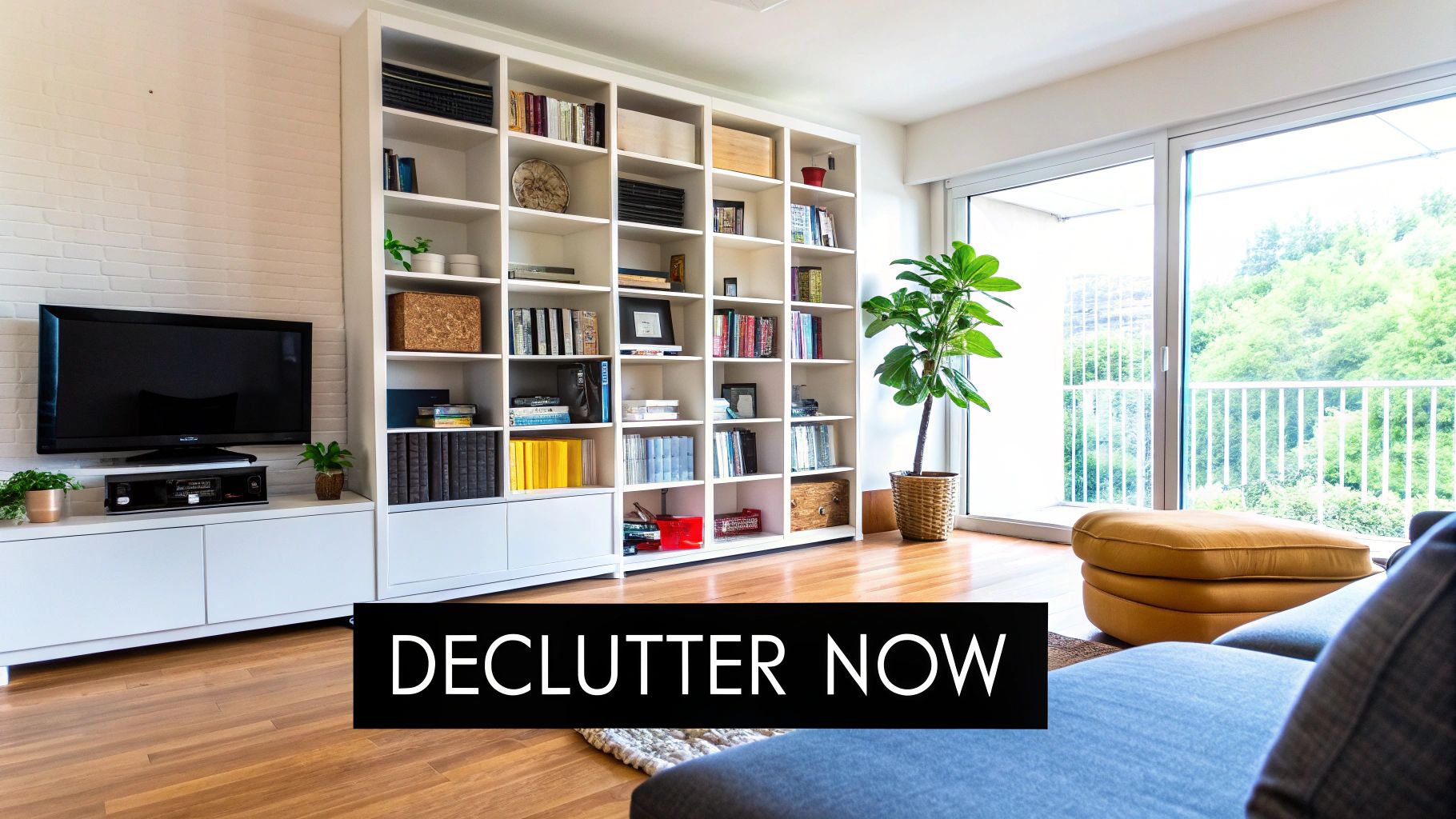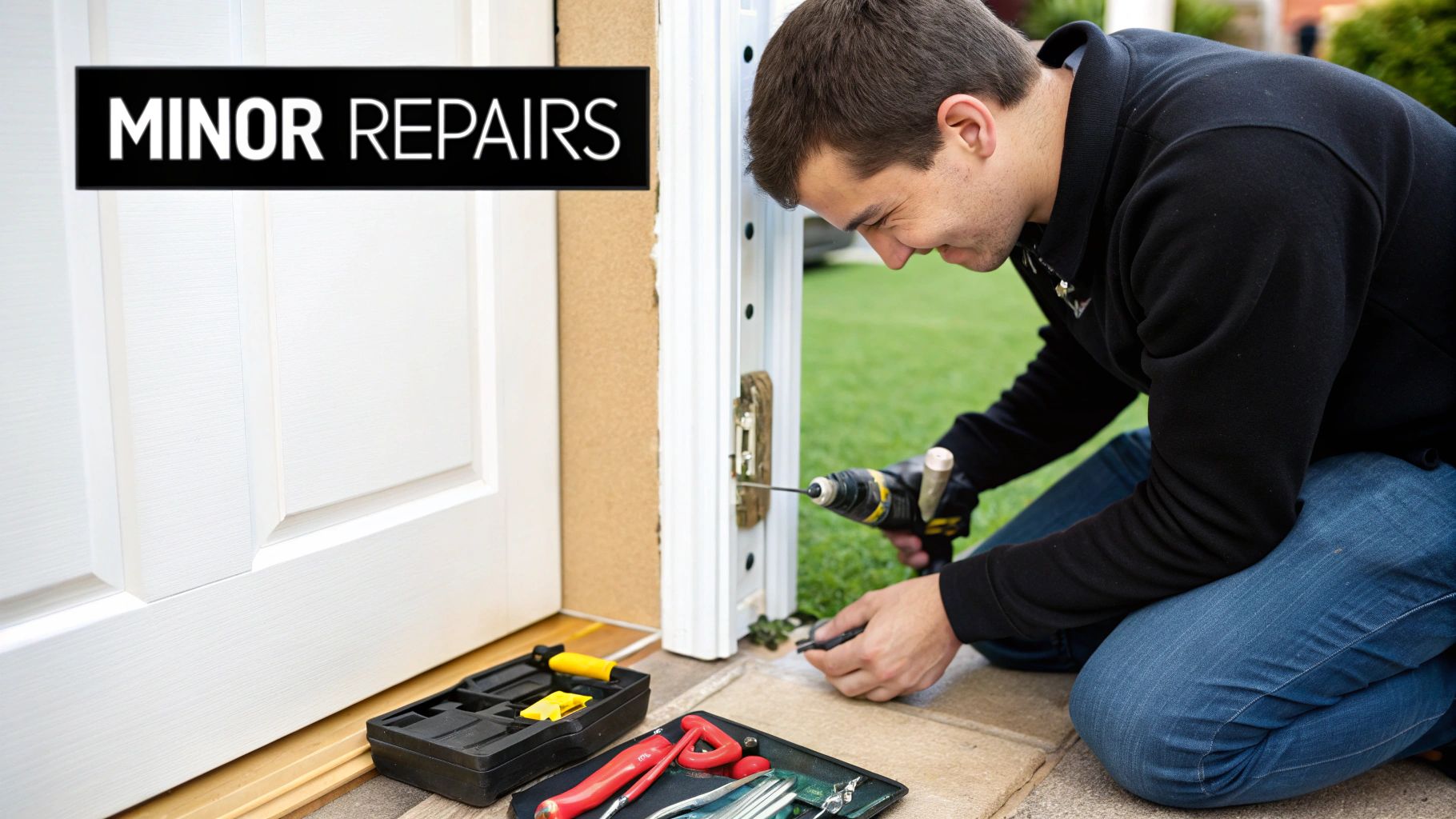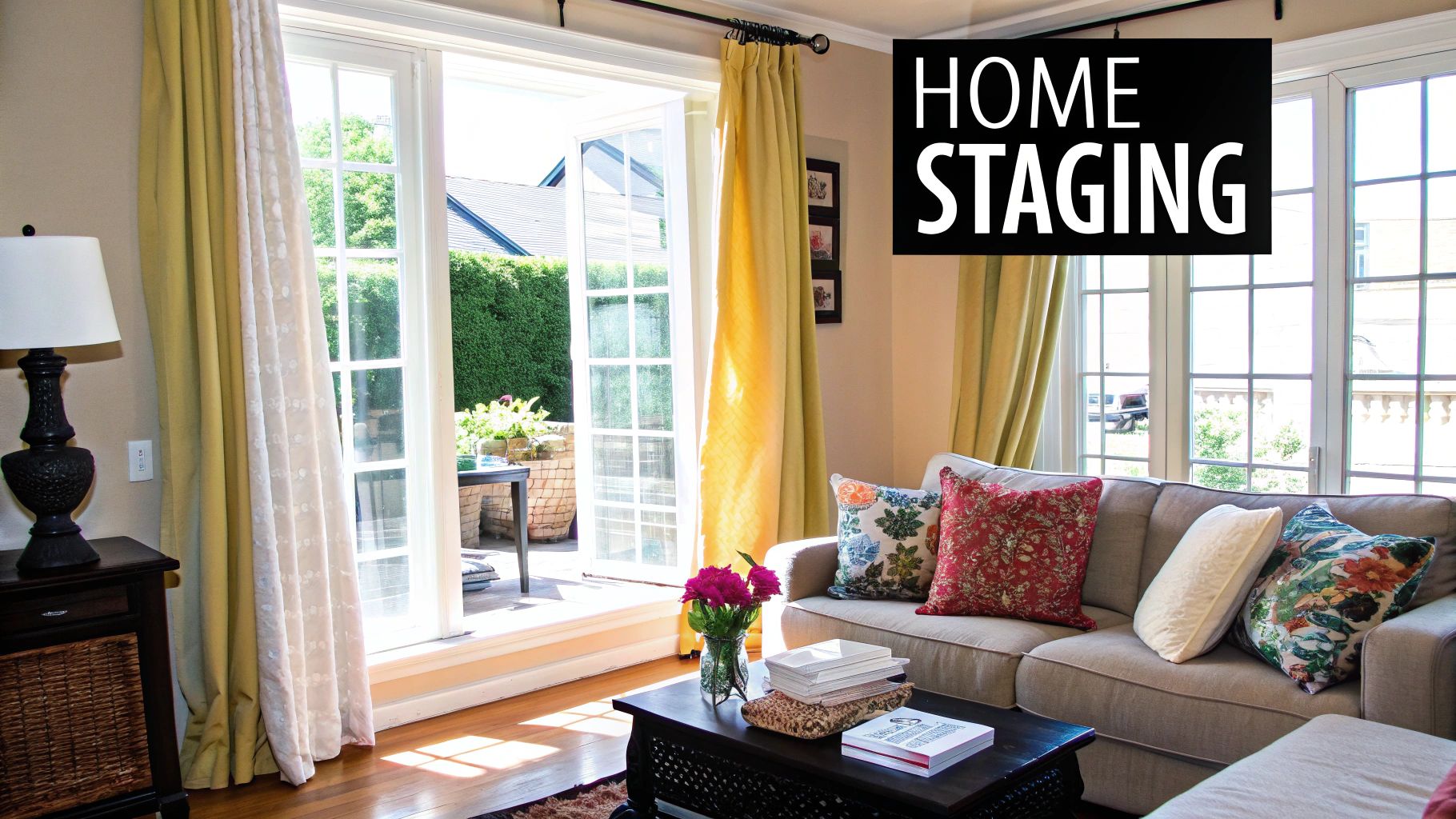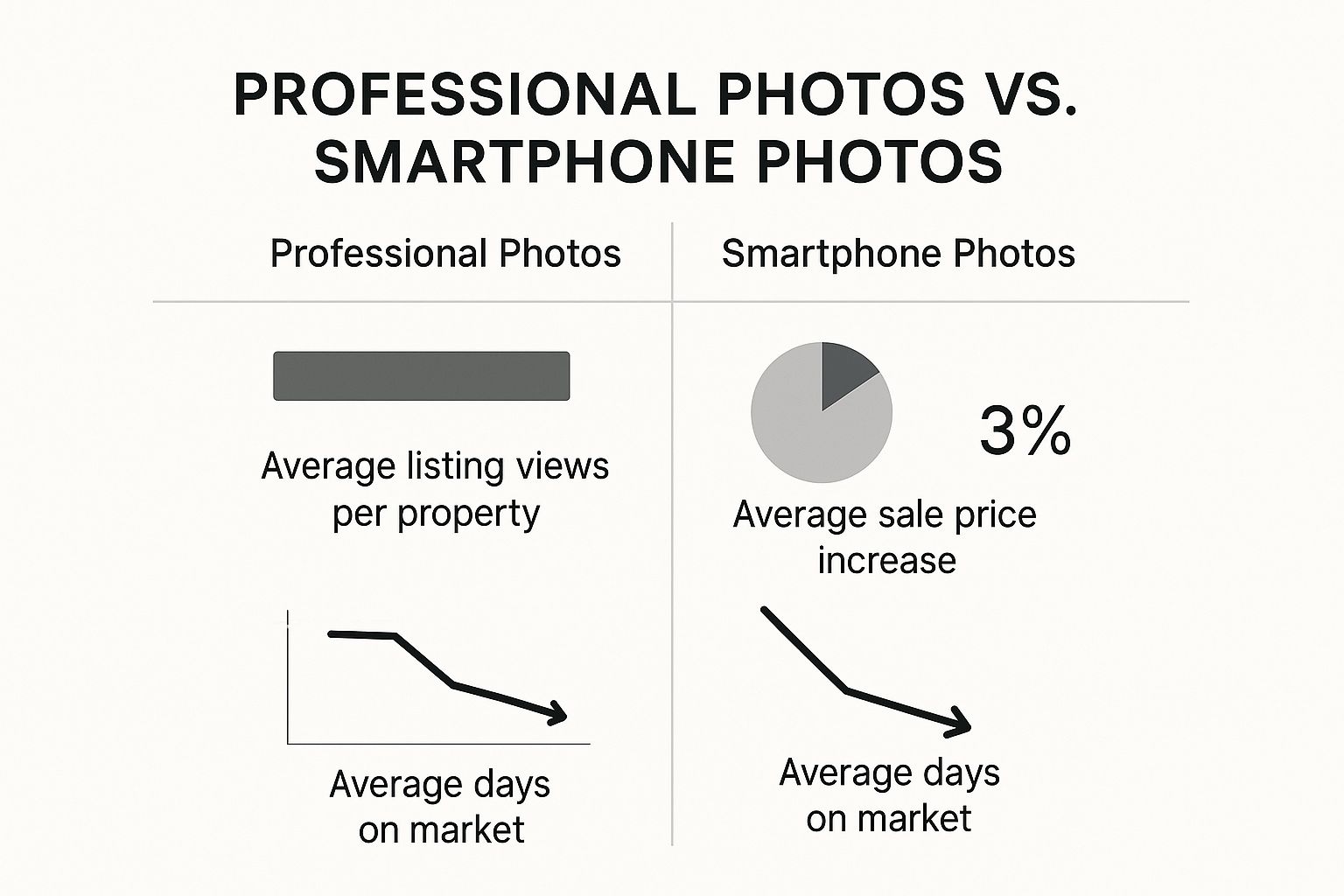Getting your home ready for sale isn't just about a quick tidy-up. It’s a strategic first move that involves decluttering, depersonalising, and deep cleaning to create a space that buyers can't resist. Think of it as creating a blank canvas, which is absolutely vital for helping potential buyers see themselves living there, leading to a faster, more profitable sale.
Your Foundation for a Successful Home Sale

Long before a buyer starts looking at the number of bedrooms or the size of the yard, they have an emotional reaction to the feel of your home. A space that’s cluttered and overly personal can be an immediate turn-off. It makes it incredibly difficult for them to look past your life and imagine their own. This is exactly why these first steps are the most important part of preparing your house for the market.
Declutter and Depersonalise
You need to stop thinking like a homeowner and start thinking like a buyer. That gallery wall filled with treasured family photos? It's time to pack it away. Your unique, colourful decor might be a perfect reflection of your personality, but it probably won't match a buyer's taste. The end goal here is a neutral, warm, and inviting atmosphere.
To make this less of a mammoth task, take it one room at a time. I always advise my clients to sort items into four piles: keep, store, donate, or discard. A good rule of thumb is to remove at least one-third of your belongings from every room. This is especially true for bulky furniture, which can make spaces feel much larger and more open once it's gone.
Expert Tip: Don't forget the storage areas! Buyers always look inside closets, pantries, and cupboards. An organised, half-full wardrobe instantly signals that there's plenty of storage space—a huge plus for any buyer.
The Power of a Deep Clean
With the clutter gone, it’s time to roll up your sleeves for a deep clean that goes far beyond your usual weekly routine. This isn't just about making things look nice; it's about eliminating odours and showing buyers that your home has been meticulously cared for.
To get you started, I've put together a simple checklist that organises the initial tasks by how much impact they have on a buyer's first impression.
Home Preparation Priority Checklist
This table breaks down the essential first steps, helping you focus your energy where it counts the most.
| Task | Priority Level | Estimated Impact on Buyer Perception |
|---|---|---|
| Declutter Main Living Areas | High | Creates an immediate sense of space and possibility. |
| Deep Clean Kitchen & Bathrooms | High | Signals good hygiene and a well-maintained home. |
| Depersonalise (remove photos, etc.) | High | Allows buyers to mentally "move in." |
| Wash Windows Inside & Out | Medium | Maximises natural light, making rooms feel brighter. |
| Clean Skirting Boards & Switches | Medium | Shows attention to detail and care. |
| Organise Closets & Pantry | Medium | Highlights storage potential, a key selling feature. |
| Steam Clean Carpets | Low | Removes lingering odours and freshens the space. |
| Tidy Garage & Shed | Low | Shows all areas of the property have been looked after. |
Tackling the "High" priority items first will give you the biggest bang for your buck in terms of effort versus buyer appeal. The smaller details can then follow to polish the final presentation.
These efforts aren't just for show. In a competitive market, a beautifully presented home can sell up to 20-30% faster. This initial preparation truly sets the stage for everything else, from the professional photos to the home opens, and heavily influences how buyers perceive your property's value. To see how this fits into the bigger picture, it's worth exploring the latest Australian property market trends to understand current buyer expectations.
Smart Repairs and Updates That Pay Off

Once you’ve decluttered and given the house a proper deep clean, it’s time to switch gears to smart, targeted improvements. This isn't about blowing the budget on a massive renovation. Instead, we’re focusing on strategic fixes that give you the best bang for your buck. The goal is simple: eliminate any red flags that could make a buyer hesitate or, worse, low-ball their offer.
The best way to start is with your own inspection. Grab a notepad, walk through your property, and try to see it through the eyes of a particularly fussy buyer. You're looking for those small, nagging issues that, when added up, can create an overall impression of poor maintenance.
Your Self-Inspection Hit List
Jot down every little imperfection you spot. These are usually quick and affordable fixes, but they make a world of difference to how a buyer perceives the value of your home.
- Leaky Taps: Check every single tap—kitchen, bathrooms, laundry, and even the ones outside. Drip, drip, drip is the sound of money going down the drain in a buyer's mind.
- Sticky Doors & Windows: Make sure everything opens and closes without a fight. A door that sticks can hint at foundation problems, even if it’s just a loose hinge.
- Cracked Tiles: A single cracked tile in the bathroom or kitchen can instantly make the entire space feel dated and neglected.
- Scuffed Walls & Skirting Boards: Take note of any areas that need a quick paint touch-up. It's a small detail that freshens up a room.
- Burnt-out Light Bulbs: Replace every single one. A dark room feels cramped and uninviting, so let the light in!
Tackling this list head-on shows potential buyers that your home has been genuinely cared for. This builds trust and helps justify your asking price. For a complete rundown of what to focus on, our ultimate guide to selling your home includes an exhaustive checklist to get you started.
High-Impact, Low-Cost Upgrades
Beyond the basic repairs, a few simple cosmetic updates can modernise your home and give its appeal a serious boost. These small changes signal a move-in-ready property, which is exactly what today’s buyers are looking for.
Think about swapping out dated cabinet handles in the kitchen and bathrooms for something sleek and modern. It’s a five-minute job that can completely change the feel of your cabinetry. In the same way, replacing old, tired light fixtures with contemporary ones can brighten a room and transform its entire atmosphere.
A fresh coat of neutral paint is probably the most powerful tool you have. A versatile colour like a warm white or a soft greige doesn't just cover up scuffs; it makes spaces feel bigger, brighter, and instantly more welcoming to a wider range of buyers.
These preparations are more important than ever in a competitive market. The Australian Bureau of Statistics recently reported that the mean price for a dwelling in Australia has now tipped over the $1 million mark, with the total value of all residential dwellings hitting a staggering $11.366 trillion. With a rising market comes more homes for sale, making superior presentation absolutely critical if you want to stand out. You can find out more about these national property value trends and what they mean for sellers right now.
Creating Unforgettable Curb Appeal

The first impression of your home doesn’t happen in the hallway. It happens the moment a potential buyer pulls up to the kerb. Their decision-making process kicks into gear right then and there, and a welcoming exterior can set a positive tone for the entire viewing.
That’s why spending time on your home's curb appeal is one of the most powerful things you can do when preparing your house for sale.
It’s all about creating a picture that makes people genuinely excited to see what’s inside. You don't need a massive budget, either. Simple, high-impact tasks can completely transform your home's street presence and show buyers the property has been loved and looked after, which builds crucial confidence from the get-go.
First Impressions Checklist
Your first job is to stand on the street and look at your home with brutally honest eyes. What do you see first? The good and the bad. This simple exercise helps you build a to-do list that will give you the most bang for your buck.
Here are a few essential tasks that always make a huge difference:
- Pressure Wash Everything: You’d be amazed what a high-pressure clean can do. Blasting years of built-up grime off your driveway, footpaths, and exterior walls will instantly make the whole property look fresher and brighter.
- Make Your Windows Sparkle: Clean windows are a non-negotiable. They not only look fantastic from the kerb but also let so much more natural light flood into the home when buyers are walking through.
- Give Your Front Door a Facelift: The front door is the centrepiece of your home’s entrance. A fresh coat of paint in a welcoming colour—think classic charcoal, deep blue, or even a tasteful, bold red—makes a powerful and inviting statement.
- Update Your Hardware: Don't overlook the small stuff. Swapping out a dated letterbox, tired house numbers, or an old-fashioned exterior light for modern alternatives is a quick, affordable update that signals quality.
Simple Landscaping That Sells
You don't need to be a professional landscaper to make a massive impact. A tidy, vibrant garden tells a story of a well-cared-for home. On the flip side, an overgrown, neglected yard can make buyers wonder what other, bigger maintenance jobs have been ignored.
Focus on the simple, effective actions. Start with the basics: mow the lawn, pull every last weed, and trim back any overgrown bushes or trees, especially if they're blocking light from getting into the windows.
One of the best-kept secrets for instant appeal is a fresh layer of dark mulch in your garden beds. It makes plant colours pop, keeps weeds down, and gives the whole garden a polished, professional look for very little cost.
Adding a splash of seasonal colour is another brilliant trick. A few pots of vibrant flowers near the entrance or some colourful plants tucked into your garden beds can bring so much life and energy to your home’s exterior. These small touches all work together to create an unforgettable first impression that gets buyers excited before they even step foot inside.
Mastering Home Staging for a Quick Sale
When you're selling your home, you're not just selling a building; you're selling a lifestyle. Effective staging is the art of turning your lived-in space into a desirable product, one that hooks buyers the instant they see it online. This is about more than just a quick tidy-up—it's about creating an emotional pull that helps potential buyers see their future unfolding within your walls.
Great staging really comes down to a few core principles: a neutral colour palette, smart lighting, and the right decorative touches. The aim is to create an atmosphere that feels aspirational but still warm and inviting. Think about arranging furniture to make rooms look bigger and to create a natural, easy flow from one space to the next.
Creating Space and Flow
The number one rule in my book? Make every room feel as big and bright as humanly possible. This often means taking furniture out, not putting more in. A room that’s jam-packed with furniture can feel cramped and much smaller than it actually is.
- Pull Furniture Away from Walls: It’s a common habit to push everything up against the walls, but try creating conversational zones in the middle of the room instead. This simple trick makes a space feel larger and more thoughtfully designed.
- Define Your Zones: In open-plan living areas, a well-placed rug can work wonders. Use one to clearly mark out the living area and another for the dining space. This helps buyers immediately understand how they can use the layout.
- Clear the Path: Make sure there are clear, easy-to-navigate walkways through every room, leading all the way to any outdoor areas. It creates a sense of effortless movement that buyers love.
By being intentional with what you leave in the room and how it's arranged, you can guide a buyer's attention straight to your home's best assets, whether that’s a stunning view from a window or a cosy fireplace. This is a crucial part of how you prepare your house for sale.
The Power of Professional Photography
Once your home is staged to perfection, professional photography isn't a "nice to have"—it's an absolute must. In today’s market, it is the single most powerful marketing tool at your disposal. This image really drives home just how much of a difference high-quality photos can make.

The numbers don't lie. Investing in a professional photographer translates directly to more buyer interest, a better sale price, and fewer days sitting on the market.
Market data consistently backs this up. In June 2025, Australian national home prices reached a new peak, with the annual increase representing a $40,900 jump. In competitive markets like Brisbane, where median prices are through the roof, a beautifully presented home stands out and fuels intense competition. Staging that emphasizes space and light has been proven to not only capture more buyer attention but also potentially add several percentage points to the final sale price. You can learn more about how property trends impact seller strategy to help you make smarter decisions.
DIY Staging vs Professional Staging
One of the biggest questions sellers face is whether to stage the property themselves or bring in a professional. Both have their merits, and the right choice really depends on your budget, timeframe, and design confidence.
| Factor | DIY Staging | Professional Staging |
|---|---|---|
| Cost | Lower upfront cost, mainly for materials or rental items. | Higher investment, includes consultation, furniture rental, and labour. |
| Time & Effort | Requires significant personal time for planning, sourcing, and setup. | Minimal time required from the seller; experts handle everything. |
| Expertise | Relies on your own design sense and ability to be objective. | Provides an expert, impartial eye and access to on-trend inventory. |
| Outcome | Can be very effective if done well, but may lack a polished finish. | Delivers a cohesive, market-ready look designed to appeal to buyers. |
Ultimately, whether you decide to tackle staging yourself or hire an expert, the goal is exactly the same. You want to create a warm, inviting space that feels like home to the broadest possible audience, turning those casual online browsers into serious, motivated buyers who are ready to make an offer.
Showcasing Your Home with Pro Photography
After all the hard work you've put into cleaning, repairing, and staging, there's one last piece of the puzzle that ties it all together: professional photography. You have to remember, in today's market, your home’s first "viewing" doesn't happen when a buyer walks through the front door. It happens online.
The photos in your listing are your single most powerful marketing tool. They're the difference between a buyer clicking for more details or just scrolling right on by. All your effort preparing the house will be for nothing if the photos don't do it justice. Smartphone pictures just can’t capture the light, space, and feel of a room the way a professional can. High-quality images aren't just a nice extra—they are absolutely essential for grabbing the attention of serious buyers and getting them excited enough to book an inspection.
Getting Ready for Photo Day
To get those jaw-dropping shots, your home needs to be in pristine condition on the day of the photoshoot. The photographer is there to capture the space you've created, not to tidy up. A bit of focused preparation makes a world of difference, and believe me, it shows in the final images.
Running through a final checklist before the photographer arrives is a non-negotiable. It ensures every room looks its absolute best and saves a ton of time during the shoot.
Here’s a practical to-do list for the morning of the shoot:
- Turn on every single light. That means all the lamps, under-cabinet lighting, and overheads.
- Open all blinds and curtains to flood the rooms with as much natural light as possible.
- Give all surfaces a final wipe-down, especially benchtops, mirrors, and shiny appliances.
- Hide all the clutter. We're talking tissue boxes, TV remotes, and those pesky charging cords.
- Make sure beds are perfectly made with cushions plumped and neatly arranged.
- Clear off all kitchen and bathroom counters. Leave only minimal, stylish décor.
This level of detail is what separates a good photo from a great one. It showcases a clean, well-maintained home that buyers can immediately imagine themselves living in. For a deeper dive into making your property irresistible, our ultimate guide to getting top dollar for your Mandurah house has even more of my expert tips.
Remember, the goal of professional photography is to sell a dream. Buyers are looking for a lifestyle, and your photos need to reflect the very best version of what your home offers. Bright, clean, and spacious images create that crucial emotional connection before they even step inside.
The Final Touches for Open Houses
You’ll want to apply this same level of care right before an open house. Your goal is to appeal to all the senses, creating an experience that makes buyers feel welcome and at ease from the moment they walk in.
Think about the atmosphere. A subtle, pleasant scent from a diffuser with a light essential oil can create a welcoming vibe, but please, avoid anything overpowering. Set the air conditioning or heating to a comfortable temperature so buyers feel relaxed and want to linger.
Finally, have all necessary documents, like a property brochure and the council rates notice, laid out neatly. These final, thoughtful touches help justify your asking price, show you’re a serious seller, and can help turn casual viewers into genuine contenders.
Common Questions from Home Sellers
Venturing into the home-selling process often brings up a flood of questions, and that's completely normal. From my years of experience, I've noticed that most sellers share similar concerns about getting their property ready for the market.
Knowing the answers upfront can save you time, money, and a whole lot of stress. Getting clear, straightforward advice helps you focus on what truly matters, allowing you to move forward with confidence and make smart decisions that lead to a better outcome.
How Much Should I Spend Preparing My House?
This is easily the most common question I hear, and the answer always comes down to one thing: return on investment. You don’t need to spend a fortune to make a huge impact.
A sensible guideline is to budget around 1-2% of your home's estimated value for preparations. The key is to spend this money wisely. You want to focus your funds on high-impact, cosmetic fixes that buyers notice the second they walk through the door.
- Fresh Paint: A new coat of neutral paint is one of the cheapest and most effective ways to make a home feel new and clean.
- Minor Repairs: Fixing that leaky tap, squeaky door, or cracked tile removes an objection before a buyer can even raise it. Little things add up in a buyer's mind.
- Curb Appeal: Fresh mulch, a tidy lawn, and a welcoming front door cost very little but create a powerful first impression. You only get one chance to make it.
Resist the urge to start a major renovation, like a full kitchen overhaul, unless your agent confirms it’s absolutely essential for your home to compete in the current Mandurah market. The goal is to appeal to buyers, not to over-capitalise on projects where you won't see a return.
What Are the Best Paint Colours for Selling?
When selling a house in Australia, your colour choice should be all about creating a bright, clean, and versatile canvas. You're aiming for a colour that appeals to the widest possible audience, allowing them to easily picture their own furniture and style in the space.
Stick to warm, inviting neutrals. I consistently recommend shades like Dulux 'Natural White' or 'Whisper White'. A soft greige also works wonderfully. These colours are timeless, reflect natural light beautifully, and make rooms feel larger and more open.
By choosing a popular neutral, you’re not just painting a wall; you're removing a potential barrier for a buyer. You're making it effortless for them to fall in love with the space, not your specific taste in colours.
Should I Be Here for Viewings and Open Houses?
The short answer is almost always no. It's really best to step out and let your real estate agent handle all the viewings and open for inspections.
I know it might feel strange to leave your home to strangers, but your presence can inadvertently make buyers feel awkward and rushed. They might feel like they're intruding, which stops them from opening closet doors, asking candid questions, or speaking freely with their partner about the property's pros and cons.
Your absence empowers the agent to build rapport and allows buyers to form their own objective, emotional connection to the home. For more insights on the selling journey, our beginner's guide to selling your home covers these fundamental aspects in great detail. Trust your agent to do their job—they are there to represent your best interests and secure the best possible offer.
Feeling ready to take the next step but not sure where to start? At David Beshay Real Estate, I provide a free, no-obligation property appraisal to help you understand your home's current market value and identify the most effective strategies to prepare your house for sale. Let's connect and create a plan for your success. Visit me at https://realestate-david-beshay.com.au to book your appraisal today.





Pingback: Your Free Property Appraisal Online Guide - David Beshay Real Estate - The Agency
Pingback: A Guide to Selling a Home Privately - David Beshay Real Estate - The Agency